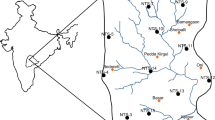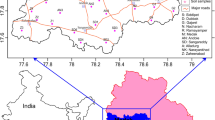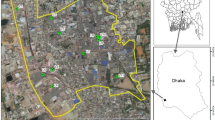Abstract
This study assessed the extent of potential human risk to heavy metal exposure by comparing concentrations of arsenic (As), cadmium (Cd), chromium (Cr), lead (Pb) and zinc (Zn) in soil in 43 vacant lots in two low income neighborhoods, Hough (Cleveland, Cuyahoga County, Ohio) and Weinland Park (Columbus, Franklin County, Ohio) in USA to the US Environmental Protection Agency (EPA)’s Soil Screening Levels (SSLs) and to regional background concentrations. At least one soil sample in all the lots in Weinland Park and 27 out of 28 (96%) of the lots in Hough exceeded the natural background concentration of Pb in Franklin (14 to 25 mg/kg soil) and Cuyahoga (56 to 136 mg/kg soil) counties, respectively. When compared to the USEPA’s SSL for Pb for human ingestion of soil, soil from only 1 out of 15 (6.6%) lots in Weinland Park and 15 out of 28 (54%) in Hough neighborhood exceeded the SSL of 400 mg Pb/kg soil. All sites in both neighborhoods exceeded the SSL for As (0.4 mg/kg soil); however only 1 lot (6.6%) in Weinland Park and 3 (11%) in Hough exceeded the background concentrations of As in Franklin (9 to 33 mg/kg soil) and Cuyahoga (5 to 20 mg/kg soil) counties. Thirteen (86%) lots in Weinland Park and 25 (89%) in Hough had soil Zn concentration higher than the background in Franklin County (71 to 177 mg/kg soil) and Cuyahoga County (56 to 137 mg/kg soil) respectively, however they were all within the SSL of 23,000 mg Zn/kg soil. Significant correlations were observed within metals, soil properties, and between metals and soil properties including texture, moisture, pH, organic matter and active carbon suggesting unique associations in the two neighborhoods. Results indicate that Pb is a metal of concern in 54% of the vacant lots in Hough neighborhood. The study highlights the need for comparing vacant lot heavy metal concentrations to both USEPA’s SSLs and natural background concentrations in the area for establishing safety of a lot prior to its use for urban agriculture.





Similar content being viewed by others
References
Accordino J, Johnson GT (2000) Addressing the vacant and abandoned property problem. J Urban Aff 22:301–315
Adams C, Bartlet D, Elesh D, Goldstein I, Yancey W (3) Philadelphia: neighborhoods, division, and conflict in a post-industrial city. Temple University Press, Philadelphia
Adriano DC (2001) Trace elements in terrestrial environments: biogeochemistry, bioavailability, and risks of metals. Springer, New York
Belluck D, Benjamin S, Baveye P, Sampson J, Johnson B (2003) Widespread arsenic contamination of soils in residential areas and public spaces: an emerging regulatory or medical crisis? Int J Toxicol 22:109–128
Blaine TW, Grewal PS, Dawes A, Snider D (2010) Profiling community gardeners. J Extension 48(6):6FEA6
Brooks RR (1972) Geobotany and biogeochemistry in mineral exploration. Harper & Row, New York
Brown KH, Jameton AL (2000) Public health implications of urban agriculture. J Public Health Policy 21:20–39
Charlesworth S, Everett M, McCarthy R, Ordonez A, De Miguel E (2003) A comparative study of heavy metal concentration and distribution in deposited street dusts in a large and a small urban area: Birmingham and Coventry, West Midlands, UK. Environ Int 29:563–573
Cleveland City Facts (2012) http://www.city-data.com/neighborhood/Hough-Cleveland-OH.html. Accessed 15 October 2013
Columbus City Facts (2012) http://www.city-data.com/neighborhood/Hough-Cleveland-OH.html. Accessed 15 October 2013
Cox CA, Colvin GH, Ohio E (1996) Evaluation of background metal concentrations in Ohio soils. Ohio Environmental Protection Agency, Columbus
Diez-Roux AV, Nieto FJ, Caulfield L, Tyroler HA, Watson RL, Szklo M (1999) Neighbourhood differences in diet: the Atherosclerosis Risk in Communities (ARIC) Study. J Epidemiol Community Health 53:55–63
Duruibe JO, Ogwuegbu MOC, Egwurugwn JN (2007) Heavy metal pollution and human biotoxic effects. Int J Phys Sci 2(5):112–118
Erdogan S, Baysal A, Akba O, Hamamci C (2007) Interaction of metals with humic acid isolated from oxidized coal. Polish J Environ Stud 16:671–675
Frink CR (1996) A perspective on metals in soils. Soil Sediment Contam 5:329–359
Gallagher FJ, Pechmann I, Bogden JD, Grabosky J, Weis P (2008) Soil metal concentrations and vegetative assemblage structure in an urban brownfield. Environ Pollut 153:351–361
Ge Y, Murray P, Hendershot W (2000) Trace metal speciation and bioavailability in urban soils. Environ Pollut 107:137–144
Gee GW, Bauder JW, Klute A (1986) Methods of soil analysis: physical and mineralogical methods. American Society of Agronomy, Madison
Girouard E, Zagury GJ (2009) Arsenic bioaccessibility in CCA-contaminated soils: Influence of soil properties, arsenic fractionation, and particle-size fraction. Sci Total Environ 407:2576–2585
Grewal SS, Grewal PS (2012) Can cities become self-reliant in food? Cities 29:1–11
Grossman GM, Krueger AB (1995) Economic growth and the environment. Q J Econ 110:353–377
Guo G, Zhou Q, Ma LQ (2006) Availability and assessment of fixing additives for the in situ remediation of heavy metal contaminated soils: a review. Environ Monit Assess 116:513–528
Holmgren G, Meyer M, Chaney R, Daniels R (1993) Cadmium, lead, zinc, copper, and nickel in agricultural soils of the United States of America. J Environ Qual 22:335–348
Jennings AA, Cox AN, Hise SJ, Petersen EJ (2002) Heavy metal contamination in the brownfield soils of Cleveland. Soil Sediment Contam 11:719–750
Jennings AA (2008) Analysis of worldwide regulatory guidance for surface soil contamination. J Environ Eng Sci 7:597–615
Kabata-Pendias A (2000) Trace elements in soils and plants. CRC Press, Florida
Lagerwerff JV, Specht A (1970) Contamination of roadside soil and vegetation with cadmium, nickel, lead, and zinc. Environ Sci Technol 4:583–586
Lewis J (1985) Lead poisoning: A historical perspective. US Environmental Protection Agency. (www.epa.gov/history/topics/perspect/lead.htm) Accessed 22 August 2013
Logan TJ, Miller RH (1983) Background levels of heavy metals in Ohio farm soils [Soil contamination, analysis]. Research Circular-Ohio Agricultural Research and Development Center. Bull. 275. The Ohio State Univ, Columbus
Ma LQ, Tan F, Harris WG (1997) Concentrations and distributions of eleven metals in Florida soils. J Environ Qual 26:769–775
McClintock N (2012) Assessing soil lead contamination at multiple scales in Oakland, California: implications for urban agriculture and environmental justice. Appl Geogr 35:460–473
McGowen S, Basta N, Brown G (2001) Use of diammonium phosphate to reduce heavy metal solubility and transport in smelter-contaminated soil. J Environ Qual 30:493–500
Mielke HW (1994) Lead in New Orleans soils: new images of an urban environment. Environ Geochem Health 16:123–128
Mielke HW, Powell ET, Shah A, Gonzales CR, Mielke PW (2001) Multiple metal contamination from house paints: consequences of power sanding and paint scraping in New Orleans. Environ Health Perspect 109:973–978
Moller A, Muller H, Abdullah A, Abdelgawad G, Utermann J (2005) Urban soil pollution in Damascus, Syria: concentrations and patterns of heavy metals in the soils of the Damascus Ghouta. Geoderma 124:63–71
Nriagu J (2007) Zinc toxicity in humans. Encycl Environ Health 801–807
OEPA (2009) Closure Plan Review Guidance for RCRA facilities. http://epa.ohio.gov/portals/32/pdf/2008CPRG.pdf. Accessed 22 September 2013
Patel IC (1991) Gardening’s socioeconomic impacts. J Ext 29:7–8
Petersen EJ, Jennings AA, Ma J (2006) Screening level risk assessment of heavy metal contamination in Cleveland area commons. J Environ Eng 132:392–404
Pouyat R, McDonnell M (1991) Heavy metal accumulations in forest soils along an urban–rural gradient in southeastern New York, USA. Water Air Soil Pollut 57:797–807
Rieuwerts J, Thornton I, Farago M, Ashmore M (1998) Factors influencing metal bioavailability in soils: preliminary investigations for the development of a critical loads approach for metals. Chem Speciat Bioavailab 10:61–75
Schilling J, Logan J (2008) Greening the rust belt: a green infrastructure model for right sizing America’s shrinking cities. J Am Plan Assoc 74:451–466
Shacklette HT, Boerngen JG (1984) Element concentrations in soils and other surficial materials of the conterminous United States: an account of the concentrations of 50 chemical elements in samples of soils and other regoliths. US Government Printing Office. USGS Professional Paper 1134-A
Smith DB, Cannon WF, Woodruff LG, Garrett RG, Klassen R, Kilburn JE, Horton JD, King HD, Goldhaber MB, Morrison JM (2005) Major-and trace-element concentrations in soils from two continental-scale transects of the United States and Canada. USGS Open-file Report 1253
Spelman W (1993) Abandoned buildings: magnets for crime? J Crim Just 21:481–495
Sweeney MJ, Brancatelli A (2012) Through Demolition, Cleveland rebuilds value. Cleveland City Council. Ohio http://www.clevelandcitycouncil.org/media/documents/publication/Ward12/urbanrebuild-final4-linksrev.pdf. Accessed 15 August 2013
Turer DG, Maynard BJ (2003) Heavy metal contamination in highway soils. Comparison of Corpus Christi, Texas and Cincinnati, Ohio shows organic matter is key to mobility. Clean Technol Environ 4:235–245
Turner A, Sogo Y (2011) Concentrations and bioaccessibilities of metals in exterior urban paints. Chemosphere 86:614–618
US Census Bureau (2010) United States Census 2010 Urban Area Facts http://www.census.gov/geo/www/ua/uafacts.html. Accessed 10 October 2013
USEPA (1996) US Environmental Protection Agency. Soil screening guidance: technical background document. Appendix A. Table A-1. www.epa.gov/superfund/health/conmedia/soil/introtbd.htm. Accessed 17 September 2013
USEPA (1998) US Environmental Protection Agency. Sources of lead in soil – A literature review. Battelle Memorial Institute. Washington, D.C www.epa.gov/lead/pubs/r98-001a.pdf. Accessed 17 September 2013
USEPA (2011) US Environmental Protection Agency. Regional Screening Level Residential Soil Tables http://www.epa.gov/reg3hwmd/risk/human/rb-concentration_table/Generic_Tables/docs/ressoil_sl_table_01run_MAY2014.pdf. Accessed 22 August 2012
USGS (2012) US Geological Survey. Mineral resources On-line spatial data, NGS Geochemistry by County http://mrdata.usgs.gov/geochem/doc/averages/countydata.htm. Accessed 10 May 2014
Venteris ER, Basta NT, Bigham JM, Rea R (2014) Modeling spatial patterns in soil arsenic to estimate natural baseline concentrations. J Environ Qual 43:936–946
Wakefield S, Yeudall F, Taron C, Reynolds J, Skinner A (2007) Growing urban health: community gardening in South-East Toronto. Health Promot Int 22:92–101
Warf B, Holly B (1997) The rise and fall and rise of Cleveland. Ann Am Acad Pol Soc Sci:208–221
Weinland Park Fact sheet (2011) Weindland Park Community Civic Organization www.weinlandparkcivic.org. Accessed 12 July 2013
Winkler E, Turrell G, Patterson C (2006) Does living in a disadvantaged area entail limited opportunities to purchase fresh fruit and vegetables in terms of price, availability, and variety? Findings from the Brisbane Food Study. Health Place 12:741–748
Woods J (2011) Warehouse fire in Weinland Park could be arson. Columbus Dispatch. Ohio http://www.dispatch.com/content/stories/local/2011/05/19/Warehouse-fire-closes-streets-in-Italian-Village.html. Accessed 26 August 2013
Acknowledgments
We would like to thank the Cleveland Planning Commission and the Hough neighborhood Land Bank for help with the identification of city owned lots in Cleveland for sampling, and the Weinland Park Neighborhood Association, Mid-Ohio Regional Planning Commission, and The Wagenbrenner Corporation for permission to sample vacant lots in the Weinland Park Neighborhood in Columbus. We also thank U.S Department of Housing and Urban Development along with the Food Innovation Center Grant for funding, Dr. Rafiq Islam of the Ohio State University for analyzing the active carbon data, and Dr. Zhiqiang Cheng, Mr. Kevin Power and Priyanka Yadav of the Urban Landscape Ecology program of the Ohio State University for assistance with sampling.
Author information
Authors and Affiliations
Corresponding author
Rights and permissions
About this article
Cite this article
Sharma, K., Basta, N.T. & Grewal, P.S. Soil heavy metal contamination in residential neighborhoods in post-industrial cities and its potential human exposure risk. Urban Ecosyst 18, 115–132 (2015). https://doi.org/10.1007/s11252-014-0395-7
Published:
Issue Date:
DOI: https://doi.org/10.1007/s11252-014-0395-7




